battery Peugeot Bipper 2008.5 Owner's Manual
[x] Cancel search | Manufacturer: PEUGEOT, Model Year: 2008.5, Model line: Bipper, Model: Peugeot Bipper 2008.5Pages: 140, PDF Size: 1.65 MB
Page 19 of 140
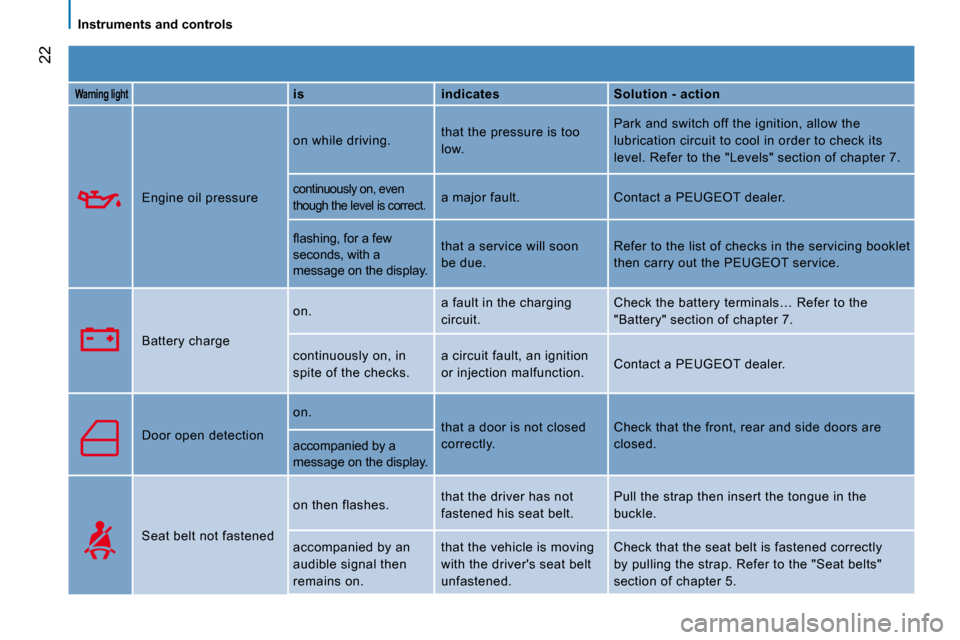
22
Instruments and controls
Warning light
is indicates Solution - action
Engine oil pressure on while driving.
that the pressure is too
low. Park and switch off the ignition, allow the
lubrication circuit to cool in order to check its
level. Refer to the "Levels" section of chapter 7.
continuously on, even
though the level is correct. a major fault. Contact a PEUGEOT dealer.
� �fl� �a�s�h�i�n�g�,� �f�o�r� �a� �f�e�w�
seconds, with a
message on the display. that a service will soon
be due.
Refer to the list of checks in the servicing bookl
et
then carry out the PEUGEOT service.
Battery charge on.
a fault in the charging
circuit. Check the battery terminals… Refer to the
"Battery" section of chapter 7.
continuously on, in
spite of the checks. a circuit fault, an ignition
or injection malfunction.
Contact a PEUGEOT dealer.
Door open detection on.
that a door is not closed
correctly. Check that the front, rear and side doors are
closed.
accompanied by a
message on the display.
Seat belt not fastened on then flashes.
that the driver has not
fastened his seat belt. Pull the strap then insert the tongue in the
buckle.
accompanied by an
audible signal then
remains on. that the vehicle is moving
with the driver's seat belt
unfastened. Check that the seat belt is fastened correctly
by pulling the strap. Refer to the "Seat belts"
section of chapter 5.
Page 28 of 140
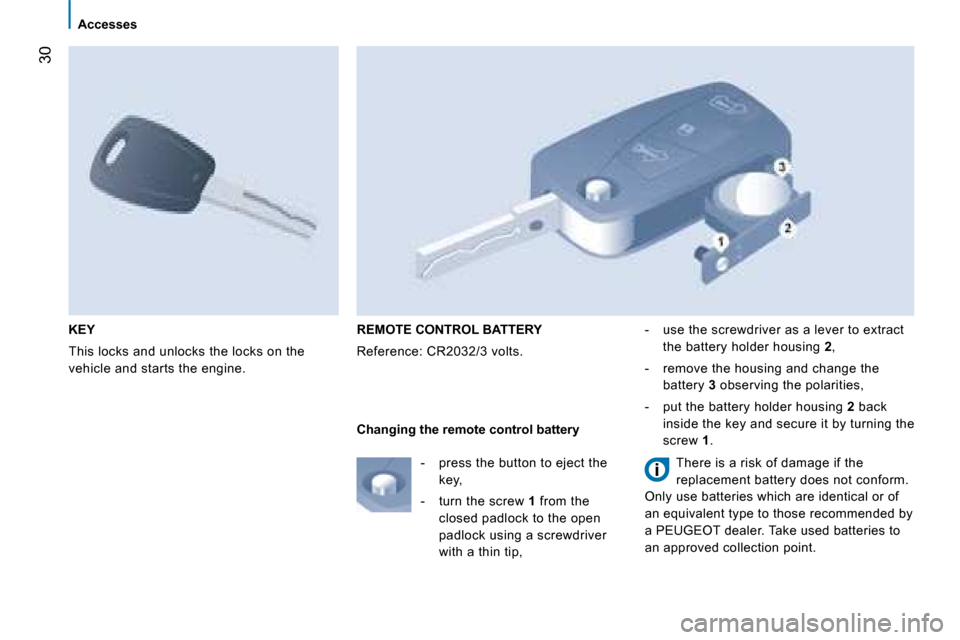
30
Accesses
KEY
This locks and unlocks the locks on the
vehicle and starts the engine.
REMOTE CONTROL BATTERY
Reference: CR2032/3 volts. - use the screwdriver as a lever to extract
the battery holder housing 2 ,
- remove the housing and change the battery 3 observing the polarities ,
- put the battery holder housing 2 back
inside the key and secure it by turning the
screw 1 .
Changing the remote control battery
There is a risk of damage if the
replacement battery does not conform.
Only use batteries which are identical or of
an equivalent type to those recommended by
a PEUGEOT dealer. Take used batteries to
an approved collection point.
- press the button to eject the
key ,
- turn the screw 1 from the
closed padlock to the open
padlock using a screwdriver
with a thin tip ,
Page 31 of 140

30
Accesses
KEY
This locks and unlocks the locks on the
vehicle and starts the engine.
REMOTE CONTROL BATTERY
Reference: CR2032/3 volts. - use the screwdriver as a lever to extract
the battery holder housing 2 ,
- remove the housing and change the battery 3 observing the polarities ,
- put the battery holder housing 2 back
inside the key and secure it by turning the
screw 1 .
Changing the remote control battery
There is a risk of damage if the
replacement battery does not conform.
Only use batteries which are identical or of
an equivalent type to those recommended by
a PEUGEOT dealer. Take used batteries to
an approved collection point.
- press the button to eject the
key ,
- turn the screw 1 from the
closed padlock to the open
padlock using a screwdriver
with a thin tip ,
Page 51 of 140
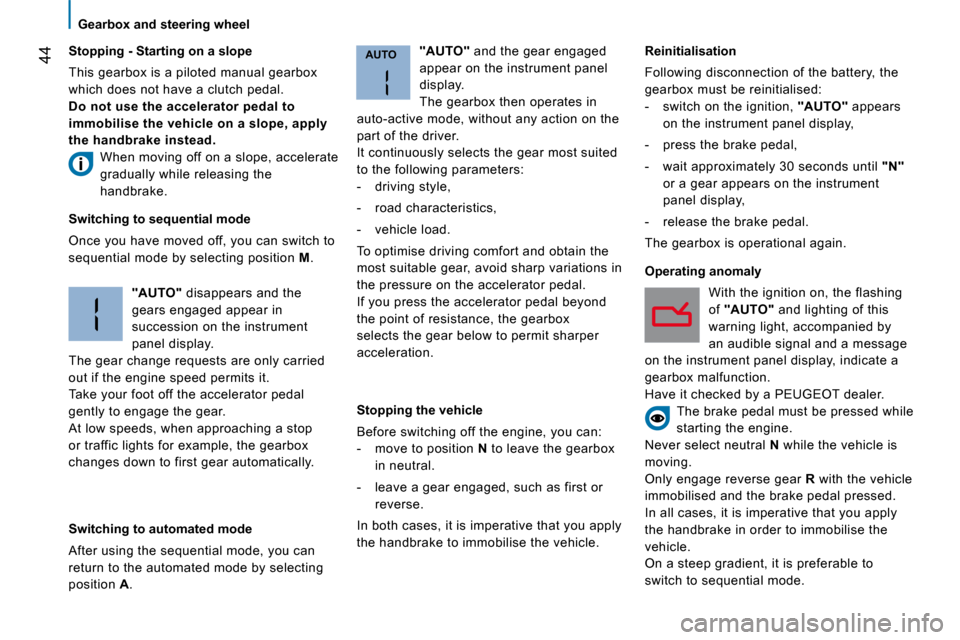
AUTO44
Gearbox and steering wheel
Stopping - Starting on a slope
This gearbox is a piloted manual gearbox
which does not have a clutch pedal.
Do not use the accelerator pedal to
immobilise the vehicle on a slope, apply
the handbrake instead.
When moving off on a slope, accelerate
gradually while releasing the
handbrake.
Switching to sequential mode
Once you have moved off, you can switch to
sequential mode by selecting position M .
"AUTO" disappears and the
gears engaged appear in
succession on the instrument
panel display.
The gear change requests are only carried
out if the engine speed permits it.
Take your foot off the accelerator pedal
gently to engage the gear.
At low speeds, when approaching a stop
or traffic lights for example, the gearbox
changes down to first gear automatically.
Switching to automated mode
After using the sequential mode, you can
return to the automated mode by selecting
position A .
"AUTO" and the gear engaged
appear on the instrument panel
display.
The gearbox then operates in
auto-active mode, without any action on the
part of the driver.
It continuously selects the gear most suited
to the following parameters:
- driving style,
- road characteristics,
- vehicle load.
To optimise driving comfort and obtain the
most suitable gear, avoid sharp variations in
the pressure on the accelerator pedal.
If you press the accelerator pedal beyond
the point of resistance, the gearbox
selects the gear below to permit sharper
acceleration.
Stopping the vehicle
Before switching off the engine, you can:
- move to position N to leave the gearbox
in neutral.
- leave a gear engaged, such as first or reverse.
In both cases, it is imperative that you apply
the handbrake to immobilise the vehicle.
Reinitialisation
Following disconnection of the battery, the
gearbox must be reinitialised:
- switch on the ignition, "AUTO" appears
on the instrument panel display,
- press the brake pedal,
- wait approximately 30 seconds until "N"
or a gear appears on the instrument
panel display,
- release the brake pedal.
The gearbox is operational again.
Operating anomaly
With the ignition on, the flashing
of "AUTO" and lighting of this
warning light, accompanied by
an audible signal and a message
on the instrument panel display, indicate a
gearbox malfunction.
Have it checked by a PEUGEOT dealer. The brake pedal must be pressed while
starting the engine.
Never select neutral N while the vehicle is
moving.
Only engage reverse gear R with the vehicle
immobilised and the brake pedal pressed.
In all cases, it is imperative that you apply
the handbrake in order to immobilise the
vehicle.
On a steep gradient, it is preferable to
switch to sequential mode.
Page 115 of 140
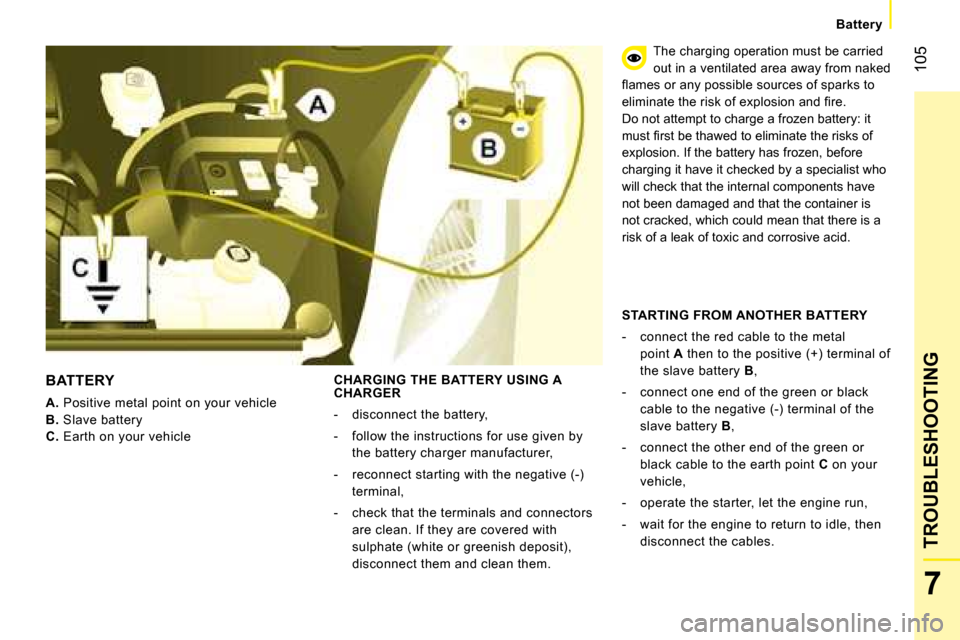
105
7
TROUBLESHOOTING
Battery
BATTERY
A. Positive metal point on your vehicle
B. Slave battery
C. Earth on your vehicle
CHARGING THE BATTERY USING A CHARGER
- disconnect the battery,
- follow the instructions for use given by
the battery charger manufacturer,
- reconnect starting with the negative (-) terminal,
- check that the terminals and connectors are clean. If they are covered with
sulphate (white or greenish deposit),
disconnect them and clean them. The charging operation must be carried
out in a ventilated area away from naked
�fl� �a�m�e�s� �o�r� �a�n�y� �p�o�s�s�i�b�l�e� �s�o�u�r�c�e�s� �o�f� �s�p�a�r�k�s� �t�o�
�e�l�i�m�i�n�a�t�e� �t�h�e� �r�i�s�k� �o�f� �e�x�p�l�o�s�i�o�n� �a�n�d� �fi� �r�e�.�
Do not attempt to charge a frozen battery: it
�m�u�s�t� �fi� �r�s�t� �b�e� �t�h�a�w�e�d� �t�o� �e�l�i�m�i�n�a�t�e� �t�h�e� �r�i�s�k�s� �o�f�
explosion. If the battery has frozen, before
charging it have it checked by a specialist who
will check that the internal components have
not been damaged and that the container is
not cracked, which could mean that there is a
risk of a leak of toxic and corrosive acid.
STARTING FROM ANOTHER BATTERY
- connect the red cable to the metal point A then to the positive (+) terminal of
the slave battery B ,
- connect one end of the green or black cable to the negative (-) terminal of the
slave battery B ,
- connect the other end of the green or black cable to the earth point C on your
vehicle,
- operate the starter, let the engine run,
- wait for the engine to return to idle, then disconnect the cables.
Page 116 of 140

106
Battery The batteries contain harmful
substances such as sulphuric acid and
lead. They must be discarded in accordance
with the provisions of the law and must not,
in any circumstances, be discarded with
household waste.
Take used batteries to a special collection
point.
Before disconnecting the battery, you must
wait for 2 minutes after switching off the
ignition.
Never disconnect a terminal when the
engine is running.
Never charge a battery without first
disconnecting the terminals.
Close the windows and doors before
disconnecting the battery.
After every reconnection of the battery,
switch on the ignition and wait 1 minute
before starting to allow the electronic
systems to be initialised. If slight difficulties
are experienced after this, please consult a
PEUGEOT dealer . It is advisable to disconnect the battery
if the vehicle is not to be used for a
period of more than one month.
If the battery has been disconnected for
some time, it may be necessary
to reinitialise the following functions:
- the display parameters (date, time, language, distance unit and temperature
unit),
- the radio stations,
- the central locking.
Some settings are cleared and must be
reprogrammed, consult a PEUGEOT dealer .
Page 128 of 140
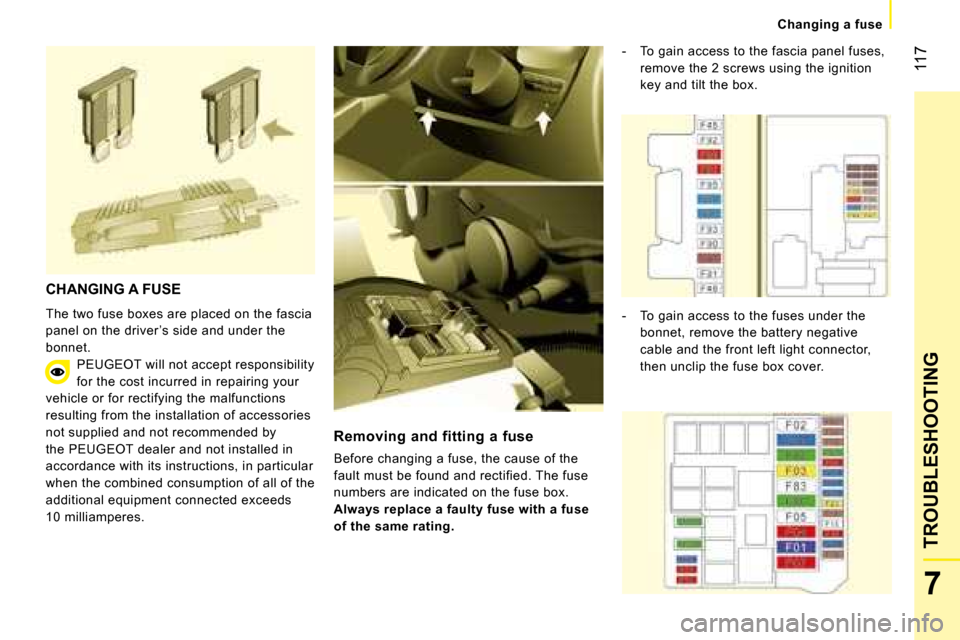
117
7
TROUBLESHOOTING
Changing a fuse
CHANGING A FUSE
The two fuse boxes are placed on the fascia
panel on the driver ’s side and under the
bonnet. PEUGEOT will not accept responsibility
for the cost incurred in repairing your
vehicle or for rectifying the malfunctions
resulting from the installation of accessories
not supplied and not recommended by
the PEUGEOT dealer and not installed in
accordance with its instructions, in particular
when the combined consumption of all of the
additional equipment connected exceeds
10 milliamperes.
Removing and fitting a fuse
Before changing a fuse, the cause of the
fault must be found and rectified. The fuse
numbers are indicated on the fuse box.
Always replace a faulty fuse with a fuse
of the same rating. - To gain access to the fascia panel fuses,
remove the 2 screws using the ignition
key and tilt the box.
- To gain access to the fuses under the bonnet, remove the battery negative
cable and the front left light connector,
then unclip the fuse box cover.
Page 130 of 140
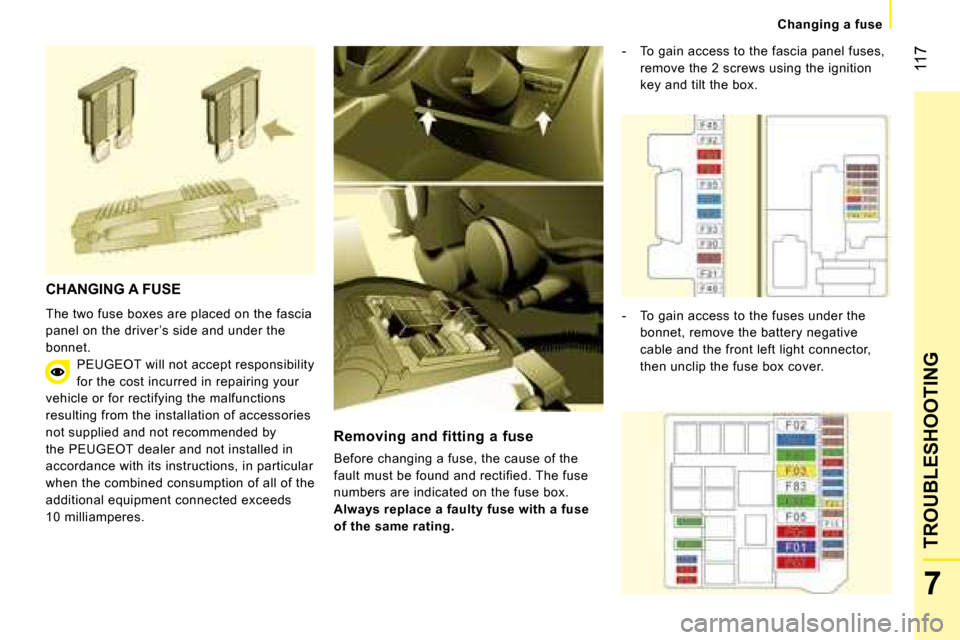
117
7
TROUBLESHOOTING
Changing a fuse
CHANGING A FUSE
The two fuse boxes are placed on the fascia
panel on the driver ’s side and under the
bonnet. PEUGEOT will not accept responsibility
for the cost incurred in repairing your
vehicle or for rectifying the malfunctions
resulting from the installation of accessories
not supplied and not recommended by
the PEUGEOT dealer and not installed in
accordance with its instructions, in particular
when the combined consumption of all of the
additional equipment connected exceeds
10 milliamperes.
Removing and fitting a fuse
Before changing a fuse, the cause of the
fault must be found and rectified. The fuse
numbers are indicated on the fuse box.
Always replace a faulty fuse with a fuse
of the same rating. - To gain access to the fascia panel fuses,
remove the 2 screws using the ignition
key and tilt the box.
- To gain access to the fuses under the bonnet, remove the battery negative
cable and the front left light connector,
then unclip the fuse box cover.
Page 134 of 140

122
Fuel
FILLING WITH FUEL
Low fuel level
When the minimum fuel tank
level is reached, this warning
light comes on. At this moment,
you have approximately 6 litres
remaining. Fill up without delay to avoid
running out of fuel.
� �T�h�e� �f�u�e�l� �t�a�n�k� �m�u�s�t� �b�e� �fi� �l�l�e�d� � with the engine
off .
- Open the fuel filler flap.
- Support the cap with one hand.
- With the other hand, insert the key, then turn it a third of a turn.
- Remove the cap.
FUEL CIRCUIT DEACTIVATED
In the event of a serious collision, a device
automatically cuts off the fuel supply to the
engine and the vehicle’s electrical supply.
It also triggers the automatic unlocking of
the doors and switching on of the courtesy
lights. A message appears on the instrument
panel display according to version.
Turn the key to the STOP position to prevent
discharging of the battery.
Check that there is no smell or leak of fuel
outside the vehicle. When the fuel filler flap is open, a
safety system prevents sliding of the
side door.
A label affixed to the inside of the flap
reminds you of the type of fuel to be used.
When filling the fuel tank, do not continue
after the 3rd cut-off of the nozzle. This could
cause malfunctions.
The capacity of the fuel tank is
approximately 45 litres.
After filling the fuel tank, lock the cap and
close the flap.
Re-activation
To set off again, restore the fuel supply and
the electrical supply manually:
- with the key in the STOP position, turn
the key to the RUNNING position,
- push the direction indicators control up fully,
- place it in the "Off" position,
- press the direction indicators control down fully,
- return it to the "Off" position,
- push it up fully again,
- return it to the "Off" position,
- press it down fully again,
- return it to the "Off" position,
- turn the key to the STOP position.
Page 140 of 140
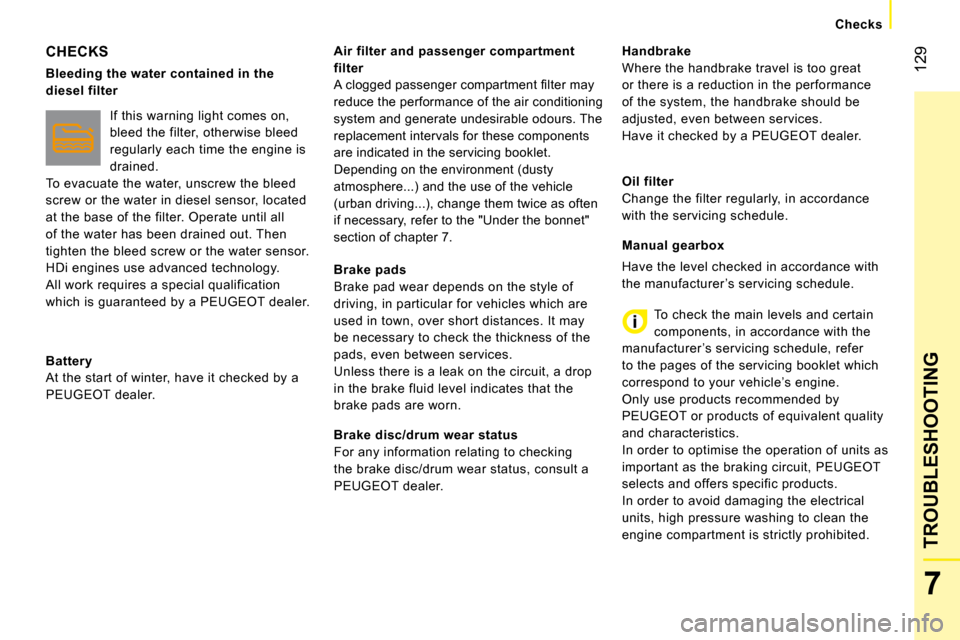
129
7
TROUBLESHOOTING
Checks
CHECKS
Bleeding the water contained in the
diesel filter
If this warning light comes on,
bleed the filter, otherwise bleed
regularly each time the engine is
drained.
To evacuate the water, unscrew the bleed
screw or the water in diesel sensor, located
at the base of the filter. Operate until all
of the water has been drained out. Then
tighten the bleed screw or the water sensor.
HDi engines use advanced technology.
All work requires a special qualification
which is guaranteed by a PEUGEOT dealer .
Battery
At the start of winter, have it checked by a
PEUGEOT dealer .
Air filter and passenger compartment
filter
� �A� �c�l�o�g�g�e�d� �p�a�s�s�e�n�g�e�r� �c�o�m�p�a�r�t�m�e�n�t� �fi� �l�t�e�r� �m�a�y�
reduce the performance of the air conditioning
system and generate undesirable odours. The
replacement intervals for these components
are indicated in the servicing booklet.
Depending on the environment (dusty
atmosphere...) and the use of the vehicle
(urban driving...), change them twice as often
if necessary, refer to the "Under the bonnet"
section of chapter 7.
Brake pads
Brake pad wear depends on the style of
driving, in particular for vehicles which are
used in town, over short distances. It may
be necessary to check the thickness of the
pads, even between services.
Unless there is a leak on the circuit, a drop
in the brake fluid level indicates that the
brake pads are worn.
Brake disc/drum wear status
For any information relating to checking
the brake disc/drum wear status, consult a
PEUGEOT dealer .
Handbrake
Where the handbrake travel is too great
or there is a reduction in the performance
of the system, the handbrake should be
adjusted, even between services.
Have it checked by a PEUGEOT dealer .
Oil filter
Change the filter regularly, in accordance
with the servicing schedule.
Manual gearbox
Have the level checked in accordance with
the manufacturer ’s servicing schedule.
To check the main levels and certain
components, in accordance with the
manufacturer ’s servicing schedule, refer
to the pages of the servicing booklet which
correspond to your vehicle’s engine.
Only use products recommended by
PEUGEOT or products of equivalent quality
and characteristics.
In order to optimise the operation of units as
important as the braking circuit, PEUGEOT
selects and offers specific products.
In order to avoid damaging the electrical
units, high pressure washing to clean the
engine compartment is strictly prohibited.